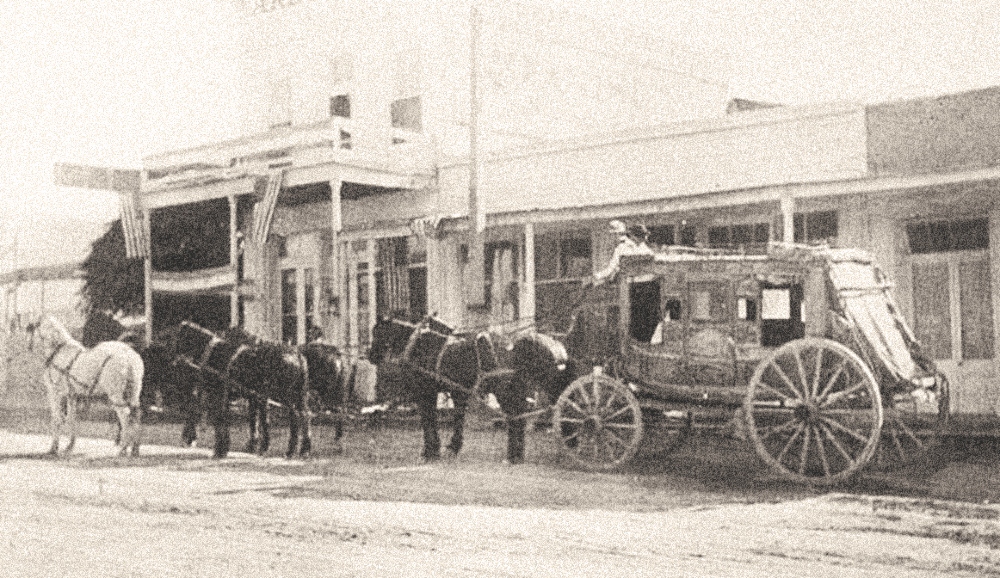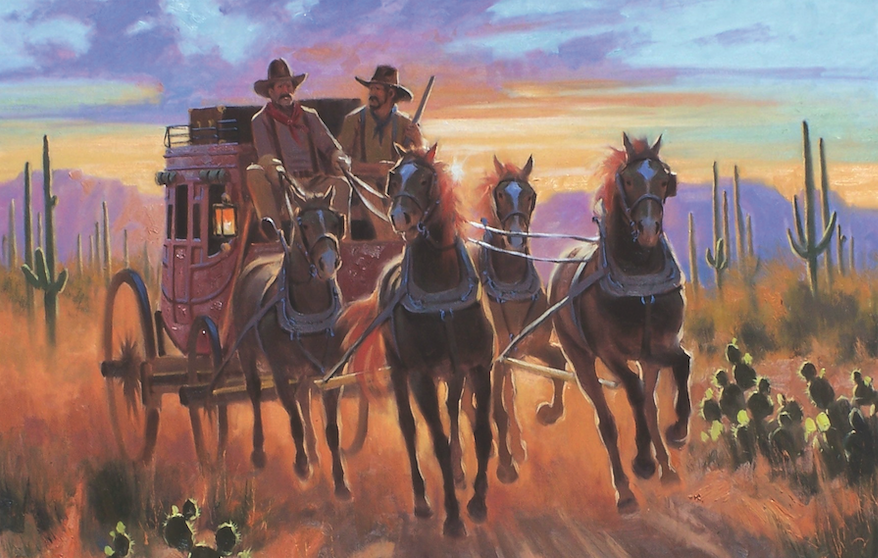Those familiar with the name John D. Kinnear may recall he was proprietor of the Tucson and Tombstone Express stagecoach line (later known as the Arizona Mail and Stage Line). In 1879 he started regular service between those two Arizona Territory towns.
His previous exploits and personal life have not received much attention, yet Kinnear was a man with a history of adventure, multiple careers and several wives.
Kinnear’s stage line might have gone unremembered had not bandits attacked one of his treasure-bearing coaches on March 15, 1881, killing driver Eli “Bud” Philpott (or Philpot) and passenger Peter Roerig. As the stage traveled between Contention and Drew’s Station several armed men stepped into the road, cried out, “Hold!” and then abruptly opened fire.
Struck by one of the shots, Philpott fell between the traces into the road, and the horses broke into a run. As the stage careened away, Wells, Fargo & Co. detective and shotgun messenger Bob Paul returned fire and hollered the classic reply, “I hold for nobody!” Men from Drew’s Station recovered Philpott’s body. He was just 27 and had been in Kinnear’s employ for a year.
Kinnear’s business competition came from his former office agent Howard C. Walker and rancher William “Billy” Ohnesorgen. In the spring of 1880 Kinnear and Walker briefly teamed up to form the Arizona Mail and Stage Co. By March 1881, the month of the Drew’s Station holdup, Kinnear was again on his own, this time as the Arizona Mail and Stage Line.
GET HISTORY’S GREATEST TALES—RIGHT IN YOUR INBOX
Subscribe to our HistoryNet Now! newsletter for the best of the past, delivered every Monday and Thursday.
OHIO-BORN FRONTIERSMAN
The only known Kinnear obituary, housed at Arizona State University’s Hayden Library in Tempe, is from a 1916 newspaper. While not all information in the obituary can be corroborated, it does detail a hardworking quintessential frontiersman.
Kinnear was born in Marion, Ohio, on April 26, 1840. He learned blacksmithing and wagon making—trades that likely came in handy in the stagecoach business. He married and had two children. At some point his young family died, and Kinnear eventually moved to Colorado.
In addition to stints in law enforcement, he reportedly ran a stage station on Ben Holladay’s Overland Stage route. The obituary claims Kinnear fought Indians in New Mexico Territory before arriving in Arizona Territory. It eulogizes the deceased as having been bright and cheerful and always ready to help his fellow man.
It is doubtful Jeannie, wife No. 3 (counting No. 2, who was a common-law wife), would have agreed with that characterization, as it diverges wildly from the abusive husband she described in divorce papers. Kinnear’s love life was certainly a tangled web. By 1862 he was in Trinidad, Colorado Territory, running a gambling hall and saloon and living with an older woman, Charlotte L. Kinnear (sometimes listed as Louise Kinnear), who was reportedly his common-law wife.
“Mrs. [John D.] Kinnear [was] the only American woman in the town,” Alice Blackwood Baldwin recorded in her period memoir. Baldwin was pregnant when she arrived in Trinidad with her husband, Lieutenant Frank Baldwin, in 1867. Although Alice gave birth in the home of Spanish-speaking Señora Felipe Baca, the wife of an important local rancher, she placed more value on the help she received from “Mrs. Kinnear,” in fact the common-law wife of a saloon owner.
“The baby,” noted Alice, “was the first white child of unmixed blood born in Trinidad.”
CHRISTMAS DAY WAR
That same year John Kinnear and a business partner purchased property that included a station on the Barlow, Sanderson & Co. line. So it appears Kinnear was in the stagecoach business long before arriving in Tombstone.
That December, the racial tensions in Trinidad hinted at in Baldwin’s memoir exploded into an Anglo-Hispanic clash that became known as the Christmas Day War. Three weeks later, on Jan. 14, 1868, Las Animas County Sheriff Juan Gutiérrez Jr. resigned.
Kinnear had served as a deputy U.S. marshal during the outbreak, and in its aftermath county commissioners appointed him to replace Gutiérrez. Apparently Kinnear handled the fallout from the Christmas Day War and his duties well, for when officials laid out a town plat in 1872, one of the streets was named “Kinnear.”
On Dec. 10, 1872, in Pueblo, Colo., Kinnear married third wife Jeannie, who was about a dozen years younger than him. Within months of the wedding, however, John faced a charge of bigamy. Apparently the charge stemmed from references to Charlotte Kinnear as his legal spouse, when in fact they had only lived together, though she had taken his name. In June 1873 the district court found John not guilty, and Jeannie stood by him.
The Kinnears arrived in Cochise County, A.T., in 1877 and settled on a ranch at the north end of the Whetstone Mountains, about 7 miles from the town of Benson. Jeannie reportedly enjoyed prospecting in the foothills. But in 1888 she filed for divorce and moved into town.
RUMORS OF INFIDELITY and abuse
The divorce papers raised embarrassing questions about John’s character. Apparently someone outside the family had spread rumors that prompted John to hit Jeannie in the face hard enough to draw blood. According to Jeannie, John also used profane language and threatened she would be his wife in name only.
After years of dealing with stubborn horses and mules, the stagecoach man certainly could have developed a colorful repertoire of profanity. The couple subsequently slept in separate quarters. Prior to John’s alleged abuse, Jeannie claimed (as do many women in divorce cases) to have been a “dutiful and faithful wife.”

When filing for divorce, Jeannie also questioned John’s fidelity. In 1883 John’s niece Mary Kinnear moved into the ranch house. Five years later, when Jeannie left John and took up residence in Benson, she happened to come into possession of a letter meant for him from a young woman who had been living at the ranch.
Jeannie was convinced something inappropriate had transpired between John and the young woman. Whether the mystery woman was Mary was unclear—the home-wrecker went unnamed in the divorce papers.
John Kinnear never answered the summons in the case, and a judge granted the divorce in May 1889. On Dec. 22, 1893, Kinnear married Lelah Hakes, a woman a full 30 years his junior. At the time of his death on Aug. 4, 1916, at age 76, Kinnear was living in the Pioneer Home in Prescott, Ariz. The death certificate lists him as married, but it was the superintendent of the Pioneer Home, not fourth wife Lelah, who filled out the form. WW
historynet magazines
Our 9 best-selling history titles feature in-depth storytelling and iconic imagery to engage and inform on the people, the wars, and the events that shaped America and the world.






